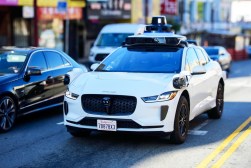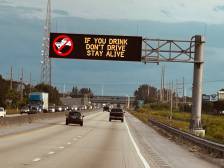States and feds tangle on autonomous vehicle policy

What if autonomous-vehicle makers had to build 50 different versions of the same car for 50 states?
This was the problem addressed by automobile industry representatives and regulators at the National Highway Traffic Safety Administration (NHTSA) Monday at a public comment meeting to discuss the agency’s Federal Automated Vehicles Policy map. The map, which was released last September by the U.S. Department of Transportation, is intended to create a single reference point for states to regulate the “design, development, testing and deployment” of autonomous vehicles.
As a growing number of states create new laws for autonomous vehicles, there is a fear that each will construct its own specifications, forcing manufacturers to design special models and creating complications for motorists who need to ride between states.
Voicing industry concerns, Global Automakers — a lobbying group representing large automobile manufacturers like Nissan, Honda, Kia, Subaru and Ferrari — urged stronger federal action to unify regulations.
“Allowing individual states to regulate the design and performance of automated vehicles would lead to a patchwork of different requirements and this would require manufactures to create different vehicles, meaning multiple design targets which would increase costs and divide development resources,” said Global Automakers Safety Manager Paul Scullion.
The old rules might not apply
In light of such challenges, NHTSA is attempting to amplify the federal role. NHTSA Administrator Mark Rosekind said that for the last 50 years there has been a clear division in state and federal authority over automobiles, drivers and roads — but the invention of autonomous vehicles could change that arrangement.
“Generally speaking, it has been the federal government’s responsibility to regulate [the production of] motor vehicles and equipment safety, while states, have regulated drivers and traffic laws.” Rosekind said. “That division of responsibility may be much less clear in a highly automated vehicle (HAV), where increasingly, the vehicle’s automated system becomes the driver.”
In response to the shift in the technology, NHTSA wants to manage all regulations dealing with autonomous vehicles, while also requesting that states continue to fulfill their traditional role of regulating traffic laws, licensing, processing car registration and handling insurance and liability issues. NHTSA calls this new division of authority the “Model State Policy.”
Despite NHTSA’s plans to set a national framework, states aren’t waiting to act. Tennessee, Nevada, Ohio, Florida and California were some of the first states to pass legislation, and on Dec. 9, Michigan added itself to that list with an unprecedented level of approval over autonomous vehicles. Signing a series of transportation bills, Michigan Gov. Rick Snyder, a Republican, legalized autonomous vehicles outright on public roads while simultaneously approving on-demand autonomous vehicle networks.
Companies like Uber have dreamed of creating such networks to provide customers a driverless and more affordable ride-sharing service. Tesla, too, has a fleet of electric cars that are now all produced with fully autonomous driving capabilities that are waiting to be activated, while the rest of the car industry is eagerly building prototypes in anticipation of new laws.
Watching the industry, state governments are facing several enticements to open regulations: Financially, there’s the allure of fresh tax revenue and high-paying jobs if a tech or auto company relocates to a given state. Environmentally, fewer cars and more electric vehicles can improve air quality. With respect to transportation, more AVs could mean less traffic congestion, more affordable travel and a technology that could save hundreds, and eventually thousands, of lives each year from accidents. In 2015 alone, for example, the Department of Transportation reported that more than 35,000 people died in vehicle crashes, 94 percent of them due to human error.
Snyder promoted autonomous vehicles as a technology that would assist residents, allowing them to be “more aware and safer” when on the roads, while simultaneously turning Michigan into a “mobility industry.”
The need for NHTSA?
Grand aspirations aside, passage of the new state laws presents conceivable hurdles for NHTSA’s implementation of a Model State Policy. Along with Michigan’s blanket approval came an official set of state regulations to govern the vehicles’ behavior on the road. The state safety requirements that managed testing of autonomous vehicles now apply to autonomous vehicle operation under any kind of public operation. Further, the state has organized its own policy unit called the Michigan Council of Future Mobility within its Department of Motor Vehicles to recommend state-specific policies.
This is exactly the kind of regulation that puts many automakers on edge as they wait for NHTSA to finalize guidelines and for states to accept them — there’s no law to compel states to accept NHTSA’s guidelines.
Another chief concern centers on testing. The representatives present said they did not want the states to decide how testing should be administered, because different tests translate to different safety and performance measurements, and this translates into different vehicle specifications — requirements they said the federal government was best positioned to handle. In support of this sentiment, the Motor Equipment and Manufacturer’s Association, a group representing parts suppliers, opposed the idea that test vehicles would be allowed to operate on approved roadways via the same criteria for allowing production cars driven by consumers.
The lobbyists called on NHTSA to increase the scope of its staffing and other resources so it can operate as a constant source of counsel for states on safety and performance regulations. William Wallace, a policy analyst for ConsumersUnion — a lobbying group for the product review site Consumer Reports — said his organization doubted that NHTSA’s suggestion for a state education program on autonomous vehicle policies was enough to ensure that states apply a uniform set of standards when approving cars for testing and operation on state roads.
“We are very concerned that states often lack the technical motor vehicle safety expertise to make this determination, and this framework will leave states in an untenable position unless they extensively consult with a well-informed, better-resourced NHTSA,” Wallace said.
Despite an aversion to state regulations, policy comments also supported states to take action when necessary and to be kept informed on regulatory information received from manufacturers. Specifically, this entailed sharing manufacturer vehicle and testing data with state departments and establishing laws that would criminalize modification of autonomous vehicle software.






